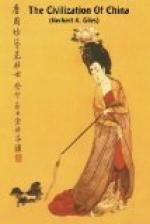Towards the close of the sixteenth century the Portuguese appeared upon the scene, and settled themselves at Macao, the ownership of which has been a bone of contention between China and Portugal ever since. It is a delightful spot, with an excellent climate, not very far from Canton, and was for some time the residence of the renowned poet Camoens. Not far from Macao lies the island of Sancian, where St. Francois Xavier died. He was the first Roman Catholic missionary of more modern times to China, but he never set foot on the mainland. Native maps mark the existence of “Saint’s Grave” upon the island, though he was actually buried at Goa. There had previously been a Roman Catholic bishop in Peking so far back as the thirteenth century, from which date it seems likely that Catholic converts have had a continuous footing in the empire.
In 1583, Matteo Ricci, the most famous of all missionaries who have ever reached China, came upon the scene at Canton, and finally, in 1601, after years of strenuous effort succeeded in installing himself at Peking, with the warm support of the emperor himself, dying there in 1610. Besides reforming the calendar and teaching geography and science in general, he made a fierce attack upon Buddhism, at the same time wisely leaving Confucianism alone. He was the first to become aware of the presence in China of a Jewish colony, which had been founded in 1163. It was from his writings that truer notions of Chinese civilization than had hitherto prevailed, began to spread in the West. “Mat. Riccius the Jesuite,” says Burton in his Anatomy of Melancholy (1651), “and some others, relate of the industry of the Chinaes most populous countreys, not a beggar, or an idle person to be seen, and how by that means they prosper and flourish.”
In 1625 an important find was made. A large tablet, with a long inscription in Chinese and a shorter one in Syraic, was discovered in central China. The inscription, in an excellent state of preservation, showed that the tablet had been set up in A.D. 781 by Nestorian missionaries, and gave a general idea of the object and scope of the Christian religion. The genuineness of this tablet was for many years in dispute—Voltaire, Renan, and others of lesser fame, regarding it as a pious fraud—but has now been established beyond any possibility of doubt; its value indeed is so great that an attempt was made quite recently to carry it off to America. Nestorian Christianity is mentioned by Marco Polo, but disappears altogether after the thirteenth century, without leaving any trace in Chinese literature of its once flourishing condition.




